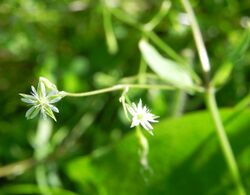Biology:Stellaria alsine
| Stellaria alsine | |
|---|---|

| |
| Scientific classification | |
| Kingdom: | Plantae |
| Clade: | Tracheophytes |
| Clade: | Angiosperms |
| Clade: | Eudicots |
| Order: | Caryophyllales |
| Family: | Caryophyllaceae |
| Genus: | Stellaria |
| Species: | S. alsine
|
| Binomial name | |
| Stellaria alsine Grimm
| |
| Synonyms | |
|
Stellaria uliginosa Murray | |
Stellaria alsine, the bog stitchwort, is a species of herbaceous perennial flowering plant in the carnation family Caryophyllaceae. It grows in bogs and marshes in Europe and parts of North America.
Description
Bog stitchwort is a rhizomatous perennial plant, with smooth, four-angled stems up to 40 cm (16 in) tall.[1] Its leaves are opposite and narrow, up to 13 mm (0.51 in) long, with untoothed margins but a few marginal hairs towards the leaf-base.[1] The flowers are borne in cymes of 1–5, arising from the axils of the higher leaves. Each flower is around 6 mm (0.24 in) in diameter, with 10 stamens, 3 stigmas, five lanceolate–triangular, green-coloured but scarious-margined sepals, and five slightly shorter white petals.[1] The petals are divided into two almost to their base with the two halves angled apart,[1] so that the two halves of each petal lie over parts of adjacent sepals.[2]
Ecology
Bog stitchwort grows in various types of wetland habitat; in the British Isles, it is especially characteristic of areas poached by cattle.[3] It flowers in spring and early summer.[1]
Distribution
Bog stitchwort is widespread in central and western Europe, but is rarer in eastern and southern Europe and the northern half of Scandinavia.[4] It is thought to be native to eastern parts of North America, but to be an introduced species in the Pacific Northwest.[1] It has also become naturalised in South America, in Asia, where it has become a weed of rice fields,[5] and on the Kerguelen Islands in the southern Indian Ocean, where it is an aggressive invasive species.[6]
Taxonomy
Stellaria alsine was first described by Johann Friedrich Carl Grimm in 1767.[1] The species has also been widely referred to under the junior synonym Stellaria uliginosa.[7]
| Wikimedia Commons has media related to Stellaria alsine. |
References
- ↑ Jump up to: 1.0 1.1 1.2 1.3 1.4 1.5 1.6 Morton, John K. (1993). "Stellaria Linnaeus, Sp. Pl. 1: 421. 1753. Gen. Pl. ed. 5, 193. 1754". in Flora of North America Editorial Committee. Magnoliophyta: Caryophyllidae, Part 2. Flora of North America. 5. Oxford University Press. pp. 99–114. ISBN 978-0-19-522211-1. http://www.efloras.org/florataxon.aspx?flora_id=1&taxon_id=200007067.
- ↑ Farmer, Carl. "Bog stitchwort, Stellaria uliginosa". West Highland Flora. http://www.plant-identification.co.uk/skye/caryophyllaceae/stellaria-alsine.htm.
- ↑ "Stellaria uliginosa". Online Atlas of the British and Irish Flora. Biological Records Centre. https://www.brc.ac.uk/plantatlas/plant/stellaria-uliginosa.
- ↑ Jalas, Jaakko; Suominen, Juha, eds (1988). Distribution of Vascular Plants in Europe. Atlas Florae Europaeae. 3. Cambridge University Press. p. 76. ISBN 978-0-521-34272-8.
- ↑ "Stellaria alsine Grimm, bog stitchwort". Go Botany. Native Plant Trust. https://gobotany.nativeplanttrust.org/species/stellaria/alsine/.
- ↑ Comité français de l'UICN (IUCN French Committee) & IUCN SSC Invasive Species Specialist Group (ISSG). "Stellaria alsine". Global Invasive Species Database. International Union for Conservation of Nature. http://www.iucngisd.org/gisd/species.php?sc=1277.
- ↑ Llewellyn, Peter (2012-02-12). "Stellaria alsine, bog stitchwort". Wild Flowers of Europe, Australia, Ireland and Britain. https://www.ukwildflowers.com/Web_pages/stellaria_alsine_bog_stitchwort.htm.
Wikidata ☰ Q163099 entry
 |

